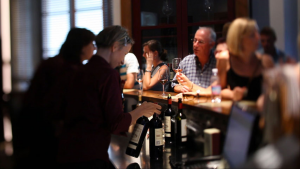What do California, Australia, South Africa and New Zealand have in common? They are all places where great wine is made and the people speak English. If you are anglophone and your wine tasting travels take you to those places, you’ll have no problems. But if you want to taste Barolos or Riojas or Burgundies or Zweigelts, you may have a few problems. It helps that English is the world’s second language, so that you’re likely to find a server or guide who can talk to and understand you.
In most cases, larger wineries with commercial tasting rooms generally hire people who can work with tourists, which means that someone there will be able to converse (at least somewhat) in English. However, much of the fun of wine tasting is meeting small producers of fine wines that you can’t find back home. These are farmers and winemakers in important but less traveled corners of Wine Country. We well remember sitting in an Italian vineyard owner’s kitchen, waiting for his daughter to arrive, so she could explain the wines he was making and serving to us.
The tasting room at Ricasoli in Tuscany, where the staff speak English very well. Photo courtesy of barone Ricasoli.
So if you are planning to taste the wines in regions where English isn’t always available, here are some tips.
- Avoid the problem. If you can’t speak their language and they can’t speak yours, you can still taste their wine or go to another winery. When you walk into a winery’s doors, look around for signs in English; that’s always a good tip-off that English is spoken there. If there are no signs, you can simply ask if there is someone who speaks English. Better still, learn how to ask that question in their language (a good suggestion for getting around any country, not just Wine Country). Really, “Parlez–vous anglais?” and “Habla ingles?” aren’t that hard to remember.
- Pick up a little wine vocabulary. We bet you knew that wine is vin in French and Spanish (thought pronounced differently) and vino in Italian. It’s wein in German. There, that’s half the battle. The French call red wine rouge, the Italians rosso and the Spanish tinto; white is blanc, bianco and blanco respectively. Now get down the words for “good”: bon in French, buono in Italian, bueno in Spanish. That wasn’t so hard, was it? You are now prepared to be a wine taster in three of the largest producing countries in Europe.
- Use whatever languages you have. Maybe you studied Spanish in high school and you’re tasting wines in Italy. The languages are very similar, thanks to those long-ago Roman conquerors. So even if you remember only a few words and phrases, give them a shot. That may be just enough for a local person to get the gist of what you’re trying to say. Once when we were in Italy we were in a situation where we didn’t speak their language and they had only a smidgen of English. But we all spoke French! So we spent our time conversing in a third, common language.
- Smile at all times and look a little helpless. In our travels, we have encountered very few people who make or sell wine who aren’t quite nice. If you try to be nice in return, they will usually want you to try and to enjoy their wines. They’ll think of you as their guests. We were in Valpolicella in Northern Italy at a winery where the owner and sole person on site could only say to us – rather loudly – RI-PA-SSO and AM-A-RONE. We sipped and said, “si, si” and we got along famously.
